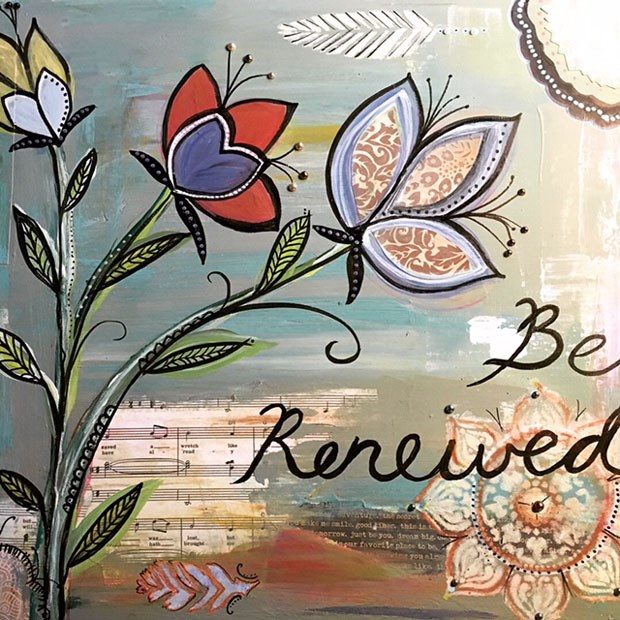“Art gives a face to the ambiguity of chronic pain…it gives a visual expression to something that is often elusive.”
–Dr. Steve Feinberg, American Chronic Pain Association
WHAT IS CHRONIC PAIN?
All of us have felt physical pain before: we’ve skinned a knee, broken a limb, pulled a muscle or have had a headache. The pain we get is one way our body tells us something is wrong and after a period of rest and healing, we go back to normal activities.
Chronic pain, however, is when our brain is in an ongoing state of pain and heightened sensitivity. Despite common understandings of pain as being a purely physical reaction, it is actually directly linked to our brain and nervous system.
The use of medication, exercise, diet, medical procedures and processing emotions can help retrain the brain and improve the quality of life of those who suffer from chronic pain.
JUST HOW MUCH DOES CHRONIC PAIN INTERFERE WITH DAILY LIVING?
The chronic pain experience is riddled with complexities because it has both physiological and psychological components, affecting the body, mind and soul. As someone who suffers with chronic pain and migraines, I hope to raise awareness of this invisible but life altering condition.
Just like mental health, chronic pain is often an invisible illness. For me, there are no scars, a cast, a cane or even a service dog to alert others about my condition. I have struggled with constant and never ceasing pain. Every. Single. Day.
For me and so many others, persistent pain makes normal activities excruciatingly difficult. For some, every movement or breath takes effort and everyday choices are made based on a delicate balance between periods of rest and activity.
Every day begins with the struggle to keep up with those around us. While each person’s experience with pain is different, there are a range of common threads: a) there is a real sense of loss, social isolation, and stigmatization; b) simple tasks unmanageable, while periods of rest and activity are carefully planned; c) the relationships between friends and family are strained as roles and expectations change drastically; d) the constant rotation of medical appointments, medication and medical procedures can be exhausting. This is why it is so important to find new ways to tackle the problem.
HOW CAN WE USE MINDFULNESS-BASED ART ACTIVITIES TO TACKLE PAIN?
Making art is a fun, non-threating and inclusive activity where one can learn new skills and coping strategies, shore up defenses and build resiliency. Mindfulness is a frame of mind; a decision is made to pay attention to the present moment when doing an activity. Mindfulness is the lens with which we view the art making process. Mindfulness-based art activities help to acknowledge the presence of pain and provide a way to get through it, moment by moment. Through my own art process, mindfulness has been an effective method of distraction, providing temporary respite from physical symptoms of pain. It can also be done with others, that both legitimizes the chronic pain experience and helps to communicate the pain experience to others.
Because mindfulness-based art activities combine body scans, breathing exercises, meditations, guided imagery and notions of acceptance, it offers a safe place to be self-reflective, learn healthy self-care habits and help you along your journey.
WHAT DO MINDFULNESS-BASED ART ACTIVITIES LOOK LIKE?
Mindfulness-based art activities are best used in a peaceful environment, where one can be completely absorbed in the moment while immersed in the process of creation. Repetitive tasks, such as knitting, colouring and playing with sand have calming attributes. While other art making focuses on a finished product, mindfulness-based art focuses purely on the process, often using art materials in simple ways. Here are a few things to try:
1) Sit comfortably and focus on your breath and acknowledge your body and how it feels. Explore different drawing mediums (chalk pastels, pencils, and markers) every few minutes as you meditate on your body. How does your body feel? Are there shapes, textures or colours that you associate with areas of your body? This exercise encourage experimentation and also brings awareness to the current state of our body, what ails it and what makes it feel good or strong.
2) Choose an object to draw and take your pencil for a ride! Begin with deep breathing and an awareness of your surroundings (focus on all the senses). Take time to observe the size, shape, angle, texture, colours of your chosen object. Place your pencil on the page and then, without lifting it, mimic the contour and details of your object. Remember, the focus is on the process, not the final product. End when you complete the contour.
3) Choose an inspirational quote or word and write it in the middle of a page. Try different lettering or whatever comes to you. Sit still and take deep breaths and draw/doodle around the quote. What does it mean to you? What do you envision? Don’t correct or change any of the marks, but accept what unfolds. Creative and reflective writing helps us to process and respond to our pain experience, accept it and how to move forward.
For those experiencing chronic pain or illness, finding new ways to find ways to reboot our nervous system can be a step towards a better moment, a better day, and a better quality of life.
Just because you have a hard life, it doesn’t mean you have to have a bad life.
With challenges or disabilities, you can still have a great life.
– Ava Neufeld, age 9
Mary Ann Burrows is an artist and a Creativity Coach at www.maryannburrows.com. Meg Neufeld is an artist, an anthropologist and program director at www.alongsideyou.ca.



